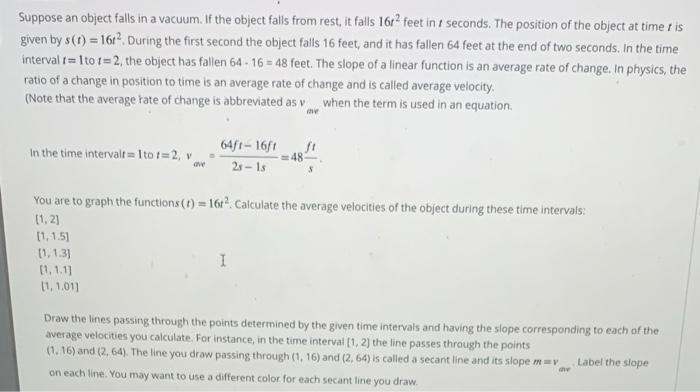Answered step by step
Verified Expert Solution
Question
1 Approved Answer
Suppose an object falls in a vacuum. If the object falls from rest, it falls 16r2 feet in 1 seconds. The position of the

Suppose an object falls in a vacuum. If the object falls from rest, it falls 16r2 feet in 1 seconds. The position of the object at time is given by s(t) = 161. During the first second the object falls 16 feet, and it has fallen 64 feet at the end of two seconds. In the time interval r=1 to 1=2, the object has fallen 64-16= 48 feet. The slope of a linear function is an average rate of change. In physics, the ratio of a change in position to time is an average rate of change and is called average velocity. (Note that the average rate of change is abbreviated as v when the term is used in an equation. ave In the time intervalt=1 to r=2, v ave 64f1-16ft 28-1s 48- You are to graph the functions (t)=16r. Calculate the average velocities of the object during these time intervals: [1,2] [1,1.5] (1, 1.3) [1.1.1] [1,1,01] Draw the lines passing through the points determined by the given time intervals and having the slope corresponding to each of the average velocities you calculate. For instance, in the time interval [1, 2] the line passes through the points Label the slope (1.16) and (2, 64). The line you draw passing through (1, 16) and (2, 64) is called a secant line and its slope mv on each line. You may want to use a different color for each secant line you draw. ave
Step by Step Solution
★★★★★
3.55 Rating (152 Votes )
There are 3 Steps involved in it
Step: 1

Get Instant Access to Expert-Tailored Solutions
See step-by-step solutions with expert insights and AI powered tools for academic success
Step: 2

Step: 3

Ace Your Homework with AI
Get the answers you need in no time with our AI-driven, step-by-step assistance
Get Started


